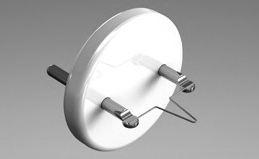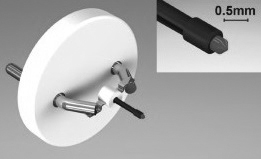How do Tungsten filaments compare to Phenom’s CeB6 source?
How do Tungsten filaments compare to Phenom’s CeB6 source?
This question requires a bit of explanation as there is no simple answer. This article is provided as clarification in response to the following Blog post: http://blog.phenom-world.com/sem-electron-source-ceb6-right-choice.


Most Tabletop or Desktop SEM’s use a standard Tungsten filament that is readily available from several microscopy consumable suppliers such as Rave Scientific, as well as others listed on our Links page. A good explanation of Tungsten and CeB6 cathodes can be found at EMS Diasum’s website. CeB6 (cerium hexaboride) filaments usually produce a stronger beam of electrons compared to Tungsten filaments. This does make the CeB6 source an attractive feature at first glance but it does come with a cost and other compromises as explained below.
Tungsten filaments are simple to replace with our pre-centered design having a semi-disposable Wehnelt and typically last from 100-200 “beam on” hours. They are easy to replace, only requiring 10 minutes most often to be back up and running in optimum condition. The design of modern Tabletop SEMs using a Tungsten filament also make it possible for the user to clean the column liner tube and replace condenser apertures if needed. This keeps the annual maintenance cost of owning such a system very low. So low in fact that service contracts or annual service maintenance agreements are typically not required or even suggested to owners of this type of SEM. This is one of the more attractive features of Tungsten filament Tabletop SEMs compared to a typical full-size SEM or the Phenom CeB6 based SEM that are often recommended to be maintained with an annual service contract resulting in an ongoing annual cost.
One claim in the above referenced blog needing clarification is regarding the end-of-life or failure of the Tungsten filament. The blog implies that upon tungsten filament failure or “burn out”, that particles are produced causing contamination and potential harmful affects to other components. Based on the first-hand knowledge of dozens of experienced owners of tungsten filament SEM’s, some for as long as 40 years – none report having concerns about filament burn-out other than the occasional inconvenience. No one reports any excessive cleaning required nor foresee potential of damage to the TMP from particles that are not created upon failure. Filaments are not “replaced weekly” but rather once they fail or using a “Filament Timer” as built into most software and replacing once they reach a set number of hours use or when current/voltage strays from normal levels.
A CeB6 (cerium hexaboride) filament produces a strong beam of electrons for exciting the sample and as a result, sometimes produce a brighter image or one with a broader range of gray-scale as compared to most Tabletop SEMs with a Tungsten filament. However, the SEC Tabletop SEM is not like “most” Tungsten filament Tabletop SEMs. The SEC systems also provide the user with flexible control over the excitation beam with a variable spot size, wider range of acceleration voltages, and more. This allows the SNE-3200 and SNE-4500 SEMs to produce nice bright images even at energies as low as 1 or 5 kV. In fact, the 1 kV beam and variable spot size allows the SEC system to produce beautiful images in high vacuum with an SE detector of non-conductive, uncoated biological samples.
The Phenom CeB6 replacement cathode or filament is typically only available through Phenom’s distributors and replaced by a factory trained service tech. Due to the high vacuum requirement of a CeB6 filament like the Phenom, the SEM is usually required to be shipped back to a qualified distributor or the manufacturer for source replacement rather than on-site. Fortunately, the CeB6 source lasts around 1500 hours and since the cost is around $900 each for the filament alone, its longer life makes it feasible economically, although quite a bit more expensive in operating cost than Tungsten filament systems.
One harder to measure cost of using a CeB6 source such as in the Phenom, is that it requires a higher vacuum level. As such, the Phenom’s column design for this high vacuum required by CeB6 means the system must be kept powered on full time to prevent loss of vacuum. Should vacuum be lost in the column, it can take about 12 hours or more for the high vacuum to once again be achieved. Thus, there is a cost to pay in regards to continuous electrical power requirements or lost time if powered down. Likewise, the Turbo Molecular Pump (TMP) and roughing pump are subjected to many more hours use during the idle time the SEM is not being but still maintaining vacuum, instead of being idle when not used for imaging. TMP’s spin at RPM’s as high as 60,000 and are one of the more costly components to replace in an SEM.
Due to the high vacuum nature and stringent cleanliness required to maintain a high vacuum like that of the Phenom CeB6 design, the CeB6 source is not recommended to be replaced by the user. Similarly, the column cannot be cleaned by the user either. As such, Phenom typically advises customers to plan for an annual source replacement depending on usage and since the system must be returned to the factory or authorized distributor, they should also plan to be without the SEM for approximately 1-2 weeks. This is evidenced by the suppliers recommending an ANNUAL SERVICE CONTRACT for maintaining the Phenom, possibly due to its critical vacuum requirements. This should be a red flag to the prospective buyer. No other tabletop SEM using Tungsten filament sources suggest much less recommend an annual service contract. Not suffering that on-going costs is a primary attraction for Tabletop SEM.
Filament Operating Cost
Prospective buyers of a Tabletop SEM are advised to weigh out these costs and compromises for their particular situation. The above referenced blog claims the “cost per image” is about the same for both type sources but this is far from correct. We have calculated the operating cost of the filament replacement only to be approximately $1.25 per hour for our Tungsten filaments and around $4 per hour for the CeB6 filament based on reported cost of replacement and lifetime expectations. The reader should make their own determinations of this on-going cost. Not factored into the cost of ownership are: shipping the system in for source replacement, cost of lost usage during replacement, extra power cost to maintain vacuum, and possibly more frequent TMP replacement cost which could be very significant.
The Tungsten filament operating cost can also be lowered even further if users wish to clean their Wehnelts and center the new filaments themselves rather than buying all new pre-centered filaments. Some users just keep an extra Wehnelt or two on hand with filament already installed and centered for when the next replacement is required and then clean the prior Wehnelt as time permits. We are also rolling out an exchange program since the Wehnelt is re-usable and is actually the major cost of a new filament/Wehnelt combination.
Questions to Ask when Considering a CeB6 based Desktop SEM like the Phenom system:
1. What is the cost to replace the CeB6 source?
2. Where is the CeB6 source replaced and how long does that take? What is the cost and how is shipping of the system facilitated?
As the tip of the CeB6 source erodes, how can it be adjusted to an optimal position in the Wehnelt to reduce image degradation?
What is the power draw of the SEM when left powered on 24/7 to maintain the column vacuum?
Should a particle from the sample dislodge and travel into the Phenom column causing imaging problems, how is the columned cleaned?
What is the cost of an annual service or maintenance contract?
Ask for evidence on the up-time of past customers systems and the rate of failures.
Consider for a moment that every single manufacturer of Scanning Electron Microscopes, both full-size and tabletop or desktop (with the exception of Phenom) offer thermonic Tungsten filament electron beam sources. One must conclude there are good reasons otherwise another SEM manufacturer would be offering something similar. Likewise, the full size SEM manufacturers also offer systems using LaB6 (or CeB6) based sources as well as Field Emission sources – usually at much greater cost. The reader is encouraged to weigh all the costs of ownership prior to making a decision based on the type of source in a Tabletop SEM.
